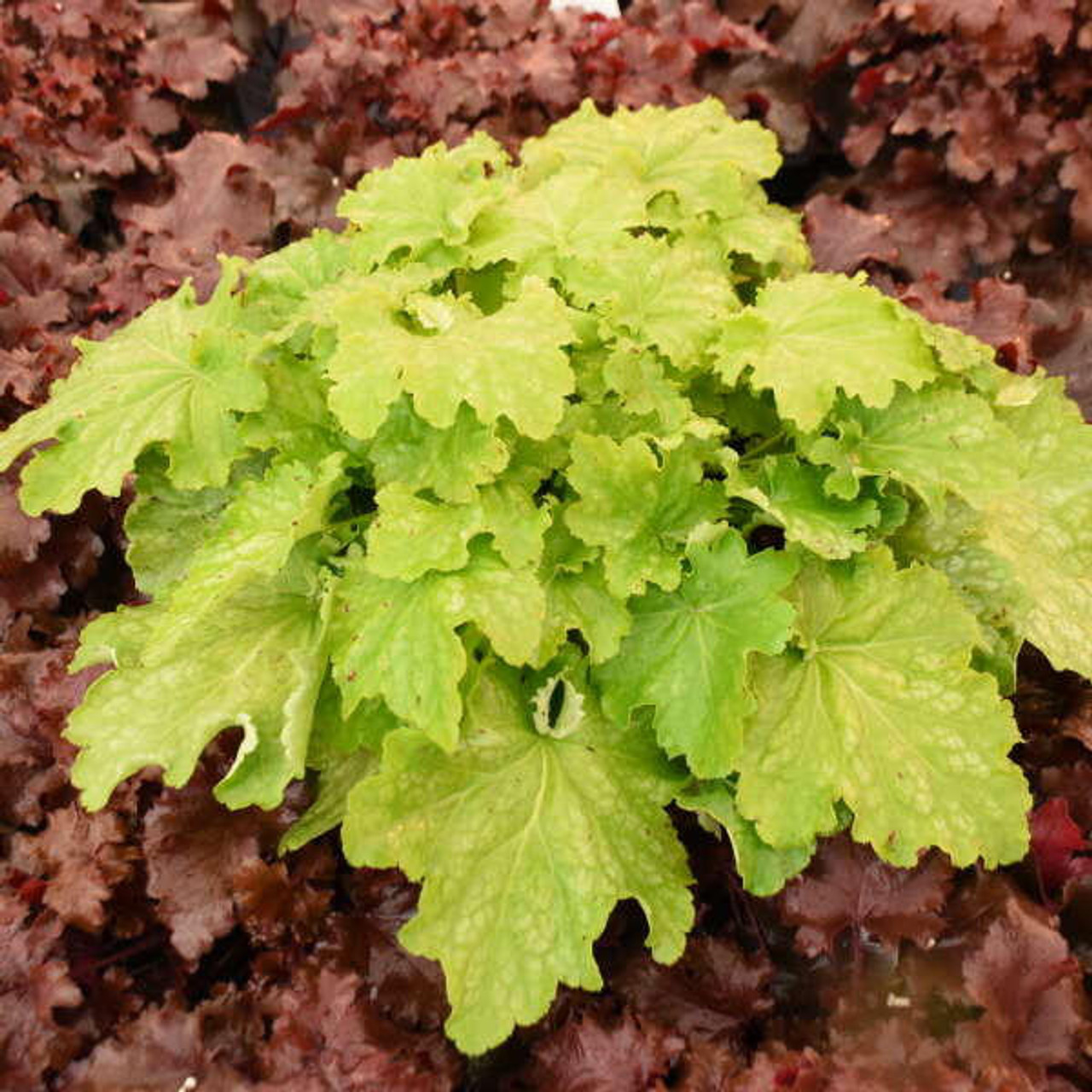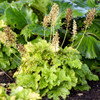Product Description
Heuchera 'Ball Gown' PPAF CPBRAF (20)ct Flat
DRESSED UP™ Series
Common Name: Coral Bells
The chartreuse companion to last year's breakout sensation 'Evening Gown'! Similar to its dark leaved compatriot, 'Ball Gown' has large, heavily ruffled leaves and excellent landscape performance. However, this plant should not be limited to only the garden bed as it has excellent presence in both mixed and mono containers. Ensure good drainage for the best performance.
Compared with PRIMO® 'Pistachio Ambrosia', 'Ball Gown' has much more scalloped leaves with a slightly serrated margin and creamy white instead of pink flowers.
Coral bells are easy to grow and blend easily with most other perennials in the landscape. Because of their low, mounding habit, they are often used as edging along paths or in containers. Try cutting a few of the tall flower scapes for fresh bouquets.
Heucheras are easy perennials to grow and fit nicely in the front of any border, rock garden, or container. They grow most vigorously and have the strongest colors when grown in partial shade (preferably afternoon shade). They can also be grown in full shade, but their growth rate will be very slow. Some varieties can withstand full sun in northern climates if they have consistent moisture, but their colors tend to fade with the intensity of the sun. The soil should be amended with organic matter prior to planting. It should also have good drainage and a neutral pH.
Heucheras are evergreen in areas with mild winters. If properly sited out of the way of winter winds and with reliable snow cover, gardeners in northern regions may also find their heucheras acting as evergreens. If the plant looks tattered by early spring, shear off any damaged leaves to make room for the vibrant new foliage which will fill in quickly.
Heucheras can be grown under Black Walnut trees because they are resistant to the toxin Juglone which the trees emit from their roots.
Heucheras are also salt tolerant. They are useful in the north along pathways which are salted in winter or for people gardening in coastal regions. Occasionally in northern regions, heucheras have a tendency to heave out of the ground because of the freeze/thaw cycle. To combat heaving, add an extra layer of compost around the plant's roots in the fall. In the spring, if the plants have heaved at all, the new roots will grow into the fresh new layer of compost.
Height: 10.0-12.0 Inches
Spread: 24.0-28.0 Inches
Scape Height: 26.0-30.0 Inches
Hardiness Zones: 4,5,6,7,8,9
Flower Color: White shades
Foliage Color: Yellow shades
Full Sun to Full Shade
Average Water Needs
Average to Fertile Soil Quality
Bloomtime: Midsummer
Attracts Butterflies and Hummingbirds
Bee Friendly
Seasonal Interest: Fall Color
Evergreen
Growth Rate: Medium
Border Plant, Container, Easy To Grow, Edging, Attractive Foliage, Mass Planting, Salt Tolerant
Heuchera 'Ball Gown', also known as Coral Bells, is a delightful perennial prized for its vibrant foliage and charming flowers. Here is what makes it so special:
Appearance:
- Foliage: The star of the show! 'Ball Gown' boasts large, heavily ruffled leaves with a unique chartreuse green color and a slight silver overlay. The dense, mounding habit creates a lush and eye-catching display.
- Flowers: Delicate white bell-shaped flowers emerge in midsummer, rising above the foliage on slender stems. The pink buds add a touch of extra color before they open.
Growing Conditions:
- Hardiness Zones: 4-9 (This means it can tolerate a wide range of temperatures)
- Light: Prefers part shade to full shade.
- Soil: Well-drained soil is essential.
- Size: Grows to about 10-12 inches tall and 24-28 inches wide.
Care:
- Low maintenance: Once established, 'Ball Gown' is relatively easy to care for.
- Watering: Water regularly, especially during dry spells.
- Fertilizing: Apply a balanced fertilizer in spring.
- Mulching: Mulching helps retain moisture and protect the plant in winter.
- Deadheading: Remove spent flower stalks to encourage more blooms.
Uses:
- Borders: Ideal for edging pathways or garden beds.
- Containers: Adds a pop of color and texture to container gardens.
- Ground cover: Can be used to create a beautiful and low-maintenance ground cover.
- Specimen plant: Its unique foliage makes it a standout in any garden.
Benefits:
- Year-round interest: The evergreen foliage provides beauty throughout the seasons.
- Attracts pollinators: The flowers attract hummingbirds and butterflies.
- Deer resistant: Generally, deer tend to avoid Heucheras.
- Easy to grow: A great choice for both beginner and experienced gardeners.
Overall, Heuchera 'Ball Gown' is a fantastic choice for adding color and texture to your garden. Its unique foliage, charming flowers, and easy care make it a must-have for any plant lover.
Other Details
The most important part of the plant is its root system. Healthy roots are the foundation of a healthy, vibrant plant. The type of plug container used is based on the specific needs of the plants. Perennials offered as bare root traditionally perform better when planted as bare root.Planted in a specialized mix, potted plants have well established root systems. Top growth stage will vary depending on the current life cycle and time of year when shipped. In Winter and early Spring dormant plants may be shipped. Dormant plants may be planted right away, even before the last frost date.
Most bare root varieties are field grown for at least one season, though Hemerocallis and Hosta are grown for two seasons. The bulk of the soil is removed during the harvesting process and the tops of most varieties are trimmed back to the crown. They are graded, packed in shredded aspen or sphagnum moss and stored in freezers until ready to be shipped.
See our Container Sizes and Bare Root Perennials pages for more information.
Plant information and care is provided in the Overview section, Plant Genus Page and general information is provided in the Planting Care & Guides. Additional questions can be asked on each Plant page.
Plant Spacing: Using the maximum mature spread or width of a plant to guide spacing, ensures space to grow to full size. To fill an area sooner, plant them closer together. Just remember, future thinning or transplanting may be needed.
Water: Keep a close eye on newly planted perennials, especially throughout the first growing year. Most early plant loss is due to too much or too little water!







